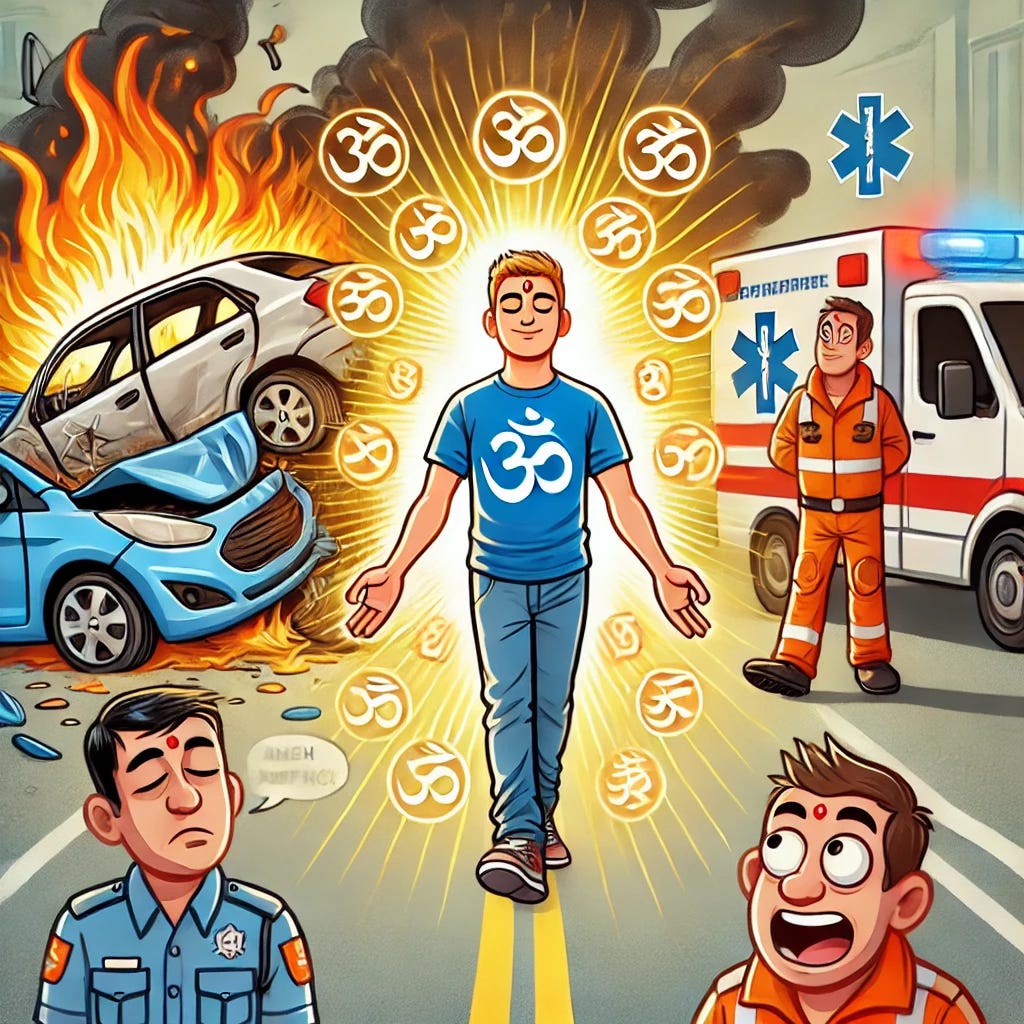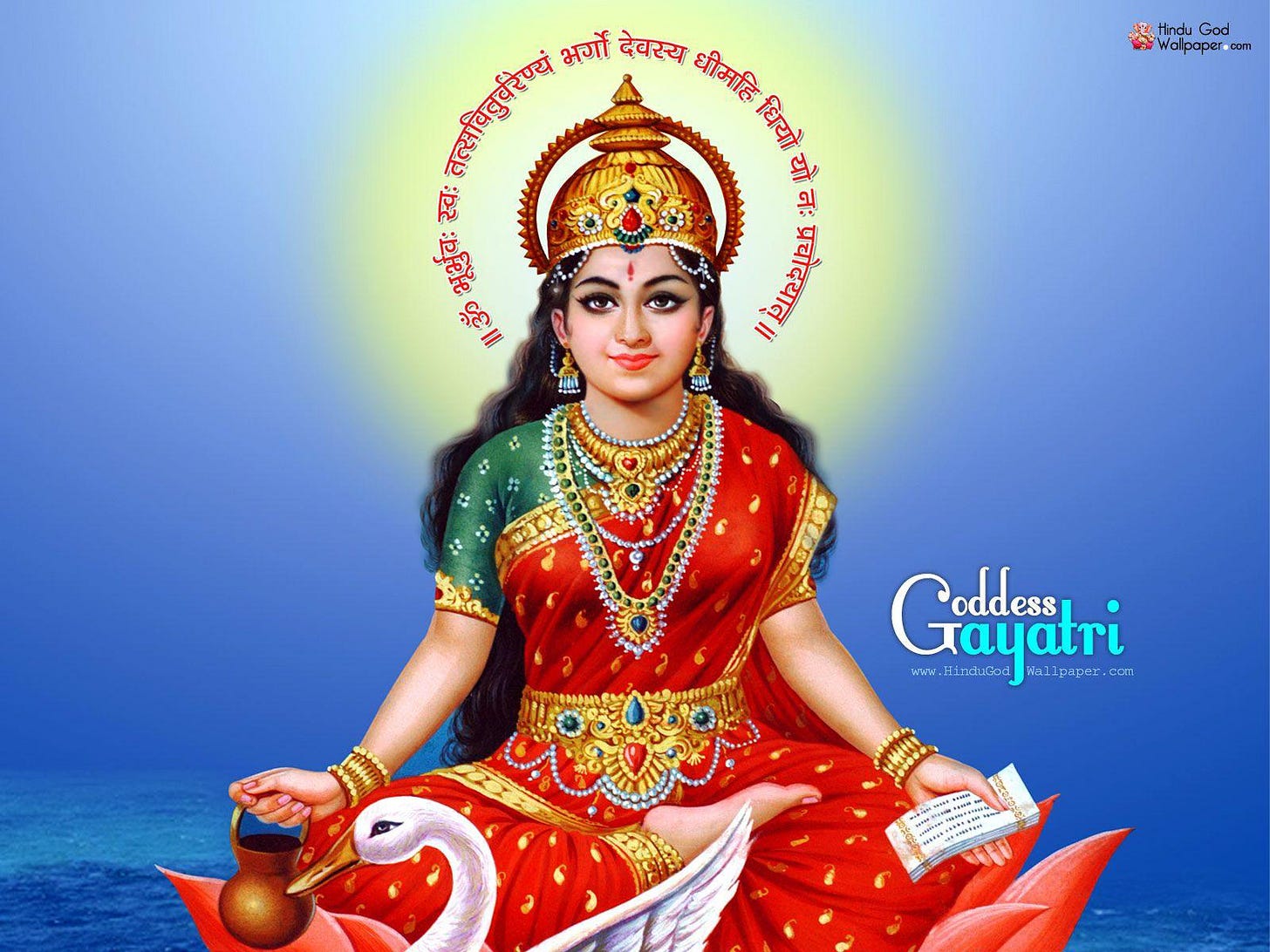I first heard about the Gayatri Mantra when I was attending a certain group that focused on Sathya Sai Baba, an Indian guru. During one of these meetings, it was shared that Sai Baba had said there was a plane crash in India in which a couple hundred people had died. He made a statement to a large gathering, saying that if anyone on the airplane had recited the Gayatri Mantra, all the people would have been protected and saved.
I thought that was kind of an outlandish statement. I mean, how could a mantra protect people from a plane crash?
I had a friend, Vijay, who was quite knowledgeable about Hinduism, so I approached him and asked, “What do you know about this Gayatri Mantra?”
He was in awe. He said, “Oh my gosh, that’s the Mother of the Vedas. It’s one of the most significant mantras you can learn,” and he was very, very excited about it.
So I said, “Why don’t we do a study circle, a gathering, to learn about the Gayatri Mantra? You can just give us the basics.”
He replied, “It would take me two weeks to talk about the Gayatri Mantra, and even then, I don’t know if I could cover all the intricacies involved in it.”
I told him, “We don’t want to become Hindu scholars. We just want a basic understanding. Can you condense it down to an hour discussion and give us the most important aspects?”
So he focused on how to take all this information and condense it into a short, digestible format. About a week later, he came up to me and said, “Thank you for saving my life!”
I was confused. I said, “What are you talking about?”
He said, “I’ve been thinking about how to condense all these aspects of the Gayatri Mantra down to one hour. And then, I got into this horrific crash on the freeway—nine cars involved, all of them totaled. But I…I walked away unscathed! I think the reason that happened could be because I was constantly thinking about the Gayatri Mantra.”
At first, I thought he was joking. I said, “Really?”
Then he showed me a picture of the car he had walked away from. It was completely crumpled, totally crushed. I said, “You walked out of this car unscathed?”
And he said, “Actually, better than unscathed.”
I asked, “How can you be better than unscathed?”
He explained, “When the paramedics arrived and started assessing who belonged to which vehicle, they asked me which car I was in. I pointed to the wreck, and they looked at me, then at the vehicle, then back at me. They said, ‘There’s no way you don’t have internal bleeding after coming out of that vehicle. You have to go to the emergency room right away.’
“I told them, ‘I feel fine,’ but they insisted, ‘No, no, you’re in shock. You’re not feeling it yet. You’re actually bleeding out right now.’
“So they put me in an ambulance and took me to the hospital. When they checked my vitals, I expected them to find something wrong, especially since I had a history of hypertension—high blood pressure. But when they measured it, my blood pressure was perfect: 120/80.
“I thought, ‘That can’t be right—I suffer from hypertension!’ But they checked again, and it was the same. They ran further tests, and I was completely fine.”
That got my attention. I thought, Wait a minute, there’s something going on here that’s much more powerful.
So I started embracing the mantra in my practice—using it, chanting it, and trying to understand it.
The Gayatri Mantra in Sanskrit:
ॐ भूर् भुवः स्वः तत् सवितुर्वरेण्यं भर्गो देवस्य धीमहि धियो यो नः प्रचोदयात्॥
How to pronounce it:
Om bhūr bhuvaḥ svaḥ tat savitur vareṇyaṃ bhargo devasya dhīmahi dhiyo yo naḥ prachodayāt.
Translation by Swami Vivekananda:
“We meditate on the glory of that Being who has produced this universe; may She enlighten our minds.”
Another funny story: I had a friend who owned a Thai restaurant in Daytona Beach. The restaurant business can be very stressful, and one day, I walked in and could see he was stressed out. He asked me, “Why are you always so peaceful?”
I told him, “You always see me in my peaceful state because I leave work behind when I come here. But I’ve also been doing the Gayatri Mantra.”
He said, “I want to learn more.”
So I gave him a pamphlet I was studying about the Gayatri Mantra and didn’t think much of it.
A week later, I came back to the restaurant, and he walked out looking completely calm and serene. I asked, “Hey, how are you doing?”
He smiled and said, “That Gayatri Mantra, man…it takes me to a place where all my troubles, worries, and fears just melt away.”
For me, personally, when I’m doing my healing work, I think of the Hindu tradition of murali, the flute that Krishna plays. When I work, I visualize myself as a hollow reed flute, allowing God’s song to play through me. And the song I’ve found to be the most effective in the healing process—particularly in Pranic Healing—is the Gayatri Mantra.
I really believe in its power. I’ve had personal experience of its protective and enlightening abilities.
I think if you listen to it for a while, you’ll find it very soothing. If you chant it, it does something to you that I can’t fully explain. Whenever I give a spiritual talk, I usually start with the Gayatri Mantra, repeating it 3 times, and it changes the energy in the room.
Traditional Vedic Interpretation:
Text: Om Bhur Bhuvah Swaha, Tat Savitur Varenyam, Bhargo Devasya Dheemahi, Dhiyo Yo Nah Prachodayat
Word-by-Word Meaning:
Om: The primal sound, representing the universal consciousness.
Bhur: The physical realm (earth).
Bhuvah: The mental realm (atmosphere).
Swaha: The spiritual realm (heavens).
Tat: That.
Savitur: Of Savitur, the Sun or divine light.
Varenyam: Worthy of worship.
Bhargo: Radiance, effulgence.
Devasya: Of the divine.
Dheemahi: We meditate upon.
Dhiyo: Intellects.
Yo: Who.
Nah: Our.
Prachodayat: May inspire or enlighten.
Source: https://indivyoga.com/complete-guide-to-the-gayatri-mantra/
A Deeper Interpretation:
Om bhūr bhuvaḥ svaḥ
This opening line sets the stage for the mantra. ‘Om’ is the universal sound, the essence of ultimate reality. It transcends boundaries, representing the mind, body, and spirit union. ‘Bhūr,’ ‘bhuvaḥ,’ and ‘svaḥ’ refer to the earth, the atmosphere, and the heavens, respectively.
They symbolize the physical, mental, and spiritual realms of existence, acknowledging the interconnectedness of our universe.
Tat savitur vareṇyaṃ
‘Tat’ means ‘that,’ referring to the transcendental. ‘Savitur’ denotes the sun, a symbol of the divine light. ‘Vareṇyaṃ’ signifies something venerable or worthy of being sought. This line is an homage to the divine light, the source of all life, urging us to seek the highest truth.
Bhargo devasya dhīmahi
‘Bhargo’ refers to the divine light that dispels all sins and suffering. ‘Devasya’ signifies ‘divine,’ and ‘dhīmahi’ means ‘we meditate upon.’ Here, we express our intent to meditate upon and absorb the divine light that purifies.
Dhiyo yo naḥ prachodayāt
‘Dhiyo’ refers to the intellect. ‘Yo naḥ’ translates to ‘who’ or ‘that which,’ and ‘prachodayāt’ means ‘inspires’ or ‘impels.’ In this final line, we pray for the divine light to inspire and guide our intellect towards righteousness.
Source: https://sampoornacollege.com/gayatri-mantra-meaning-in-english/









https://thehiddenclinic.substack.com/
They called it healing, but it forgot the memory.